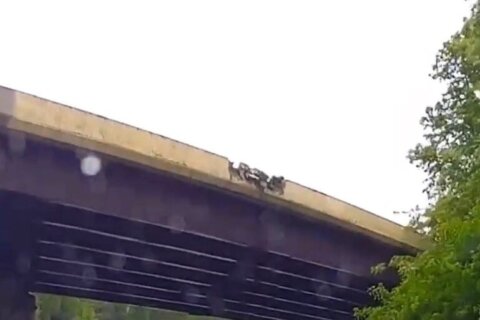This article was republished with permission from WTOP’s news partner InsideNoVa.com. Sign up for InsideNoVa.com’s free email subscription today.
This article was written by WTOP’s news partner InsideNoVa.com and republished with permission. Sign up for InsideNoVa.com’s free email subscription today.
The pandemic is likely to impact commuting across the region for years to come, according to a new analysis from the Northern Virginia Transportation Authority. Its results paint a different picture than existed just months ago.
Conducted by infrastructure engineering firm AECOM, the analysis predicts far lower vehicle miles traveled across the region in 2025 than would have otherwise occurred and, as a result, fewer traffic delays for the area’s commuters. It also projects much lower transit ridership, which could create problems for the region’s transit providers.
According to NVTA’s Transportation and Programming Principal Keith Jasper and AECOM Consulting Manager David Roden, the analysis crunched a number of data points to make its projections, including current economic data, economic projections, traffic information and a weekly nationwide survey of about 1,000 people asking about travel habits and expectations. Participants in that survey, conducted by Heart+Mind Strategies, say they are expecting to return to work well ahead of when they expected to be letting a child return to school or daycare.
The analysis projects that, all told, Northern Virginians will spend 31% less time traveling at all in 2025 than they would have.
“Telework is a phenomenon that’s likely to affect professional services, communication technology folks, higher income type-industries that have that option and employers are finding that to be a fairly cost-effective solution for them,” Jasper said. “That may cause more industries to reduce their space, their real estate, or perhaps move to other locations that don’t require so much direct interaction.”
NVTA Executive Director Monica Backmon said the analysis will help to guide decisions regarding which projects get necessary funding moving forward, both when the authority does its annual six-year plan plan update next summer and when it formulates its long-range TransAction plan, which is updated every five years. The directional plan that lays out the authority’s overarching priorities will be finished in 2022, but NVTA recently began the update process.
“This is why the impact of COVID on the application network is so important, because we need to understand some of the baseline or underlying assumptions we need to include in the plan,” Backmon said. “Even though this is the long-range plan, the plan does inform our six-year program.”
She also said that it will somewhat alter what the NVTA aims to do in the future. The trend of teleworking has a positive impact on the road network by limiting congestion. Backmon said that the authority would like to encourage continued teleworking even when the pandemic is over. But at the same time, the authority will look for ways to encourage transit use, which limits congestion in its own right and will remain a vital lifeline for working people who lack the option of telework.
“Are there potential policies to support continued teleworking at a greater level than we had before COVID while trying to mitigate the impact of transit ridership? How do we identify and help incentivize increased transit ridership?” Backmon said. “Our transit systems are very important to the region, not only because of the economic activity we see in the region, but we want to make sure that we’re accounting for the transit dependent and those who are not.”
VDOT data used in the analysis shows that in mid-April daily traffic volume was 55% lower than during the same period of 2019.
According to the report’s long-range outlook, Prince William County, Manassas and Manassas Park can expect substantially lower traffic in 2025 than would have occurred without the COVID-19 pandemic. The analysis predicts that the reduction in vehicle miles traveled (VMT) from baseline 2025 levels will range from 16% in a “quick recovery,” in which the economy recovers this fall, to 38% in a “cautious recovery,” in which schools delay reopening and business-related travel stays low. That would translate to a 48% to 84% drop in personal hours delayed.
Transit ridership is expected to remain significantly lower than pre-pandemic levels. Bus ridership has remained closer to pre-pandemic figures, but rail ridership is way down. WMATA, for example, has seen an 88% decline in ridership from the fourth quarter of 2020. Even in the most optimistic scenario — the “quick recovery” — ridership returns only to 88.5% of previous levels by the end of 2021. A “cautious recovery” would bring ridership only to 77%, according to the analysis.
Backmon said that at least some of how quickly transit ridership recovers fully will depend on federal assistance. Because of the steep decline in ridership, WMATA says it’s currently losing $2.5 million in revenue every weekday. The CARES Act provided $767 million for the system, but that money is projected to run out later in the year. At that point, the transit system — like so many others — will need more outside funding or it will have to reduce service.
“I’m hoping that it’ll be a slow and steady upswing,” Backmon said of ridership. “And it’s not solely about Metro and rail because bus service is equally important, but hopefully we will see additional support from the federal government, it’s critically important.”
According to Jasper, the analysis was conducted in late June and early July, and with the surge in COVID-19 cases in July, the likelihood of the “quick recovery” scenario is quite low. So far, Roden said, the “cautious recovery” is closest to what’s taking place according to transit data from elsewhere.







